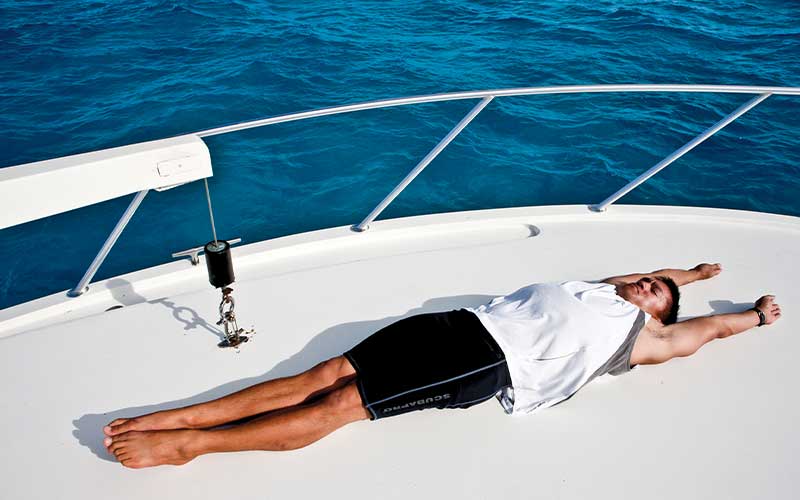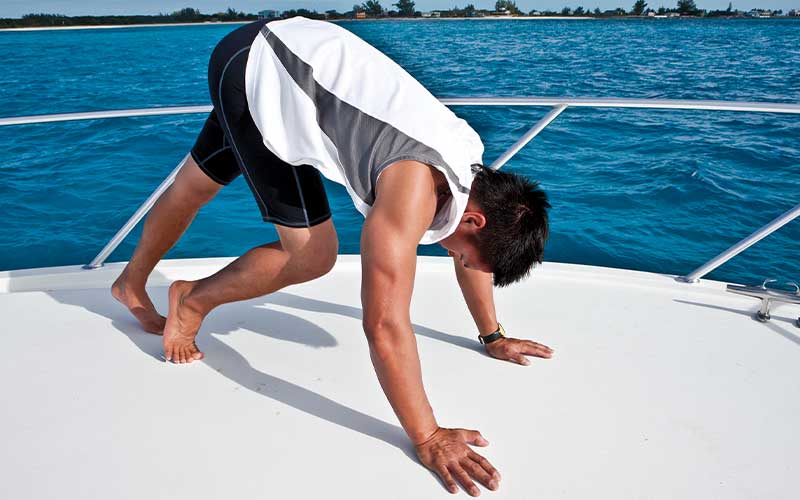In the Winter 2012 issue of Alert Diver, we described fitness as a transient phenomenon. That means the choices you make every minute of every day matter — even the choices you make while on your dream dive vacation. Unfortunately, there is no “vacation mode” for your metabolism, and no one can take your body running for you while you lounge on the deck between dives. When you put your training on hold, fitness decline is a slow but sure process. Don’t let your dream vacation be the start of your fitness demise. A liveaboard dive vacation poses particular challenges to mitigating the effects of detraining.
The exercises described here take into account you are on a dive vacation. If you choose to add exercise beyond diving and stretching, incorporate them as far from your dives as possible. Make sure the intensity is very low as well — not more than 50 percent of your maximal effort. Intense exercise is NOT recommended in the hours preceding or following your dive.
To get the most out of the space and time you have, shift your focus from traditional exercise routines to simply being healthy. Keep the “fidget factor” in mind: Every movement counts. Make smart choices each minute; it’s not just about what you do during workouts but the accumulation of movements every minute of every day. The goals are low-intensity toning and fitness maintenance.
Hydrate and Fuel Up
When spending a lot of time diving and in the sun, be sure to drink plenty of water. Sports drinks and sodas contain many empty calories, which have little or no nutritional value and will make you feel tired faster. Juices have nutritional value but can increase your caloric intake very quickly, so be selective. Making sensible food choices will provide you with more energy for diving. The human body frequently confuses thirst and fatigue with hunger, causing you to crave excess sugars. In general, a good indication of sufficient hydration is clear or light-colored, odorless urine.
Activities for Small Spaces
Try to improve your posture and stretch a lot — it feels really good. Take the opportunity to try any yoga moves you might know. It’s so easy to get caught up in the daily grind of waking to the alarm and trying to get out the door on time that we often fail to stretch in the morning. But this is your vacation; take a moment to do so in your bunk (or on the floor or deck).
Posture
Most people know maintaining good posture is important for wellness. However, few of us practice it on a daily basis. A dive vacation is a good time to increase your overall kinesthetic awareness (knowledge of where your body is in space) and begin to make good posture a habit. Start by taking a moment to consider your current posture. Next, align your back by bringing your shoulders up toward your ears and then dropping them down and back. Then briefly contract (tighten) your abdominal muscles. Try to consciously do this each time you sit down to discuss and log your dives, eat, have a cup of coffee or read a book. After about 1,000 repetitions (which accumulate faster than you think), this practice should become natural.
Basic Stretching

Lie on your back and reach way up over your head while pointing your toes, and hold for 20 to 30 seconds. Then roll over onto your stomach, press your hands onto the floor beneath your shoulders, and push your shoulders up while keeping your hips in contact with the ground. You should feel a stretch along the front of your body and through your midsection. Breathe deeply, and take a moment to focus on your body without considering what you may look like; stretch whatever area feels tight. One of the greatest barriers to fitness is concern over how we look or where it is appropriate to exercise. It is always appropriate to care for your body.
Intermediate Stretching: Upward Dog

One of our favorite yoga poses is upward dog. Lie on the floor on your stomach with the tops of your feet on the floor. Place your hands, palms down, directly under your shoulders, and press until your arms are straight (don’t lock your elbows). Your torso will lift off the ground as you straighten your arms. Rotate your shoulders back so they are pulled away from your chest. Breathe, trying to fill your lungs to the top; it should feel good. For a deeper stretch, lift your legs off the floor so only your hands and the tops of your toes are touching.
Downward Dog

To transition from upward dog to downward dog, start by shifting your body back into a kneeling position, and then elevate your torso so your hips are directly above your knees. Place your palms face down in front of you. Tuck your toes under, and press into your feet until your butt is in the air. It’s OK if your knees are bent due to tight hamstrings — they’ll loosen if you do this frequently. Be sure to adjust often as this is a big stretch. When you feel comfortable, slowly drop a knee while pressing into the opposite heel, and then switch. This will slowly stretch out your calves.
Lunges

Hold on to a stable surface at your side, step one foot backward as far as you comfortably can, and lower your body straight toward the ground. Hold this position for as long as you can comfortably hold it; you will feel a stretch in your groin and tension in your thigh muscles.
Contrary to the popular Las Vegas adage, what happens on your dive vacation does not stay on your dive vacation. Healthy choices are key to maintaining fitness. It’s not a crime to indulge — you are on vacation. However, it’s imperative that a single indulgence does not transform into throwing in the towel. Maintaining a consistent level of fitness will not only improve your dives during your trip but will also allow you to step back into your exercise routine after returning home, well rested and as fit as when you left.
NOTE: To avoid an increased risk of decompression sickness, DAN® recommends that divers avoid strenuous exercise for 24 hours after making a dive. During your annual physical exam or following any changes in your health status, consult your physician to ensure you have medical clearance to exercise.
© Alert Diver — Q2 Spring 2012